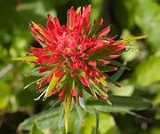
Castilleja applegatei
Encyclopedia
Castilleja applegatei is a species of Castilleja
known by the common names Applegate's Indian paintbrush and wavyleaf Indian paintbrush.
It is native to the western United States. It is a short perennial with sticky, wavy-edged leaves. It bears bright, showy paintbrush-shaped inflorescences of small red to yellowish-red tubular flowers.
Like other species of Indian paintbrush
, it is a root parasite
. Although it can survive without parasitizing other plants, individuals which take a host grow faster and larger.
There are five subspecies. They are variable in appearance but distinguishable from other Castilleja species by the wavy margins and stickiness of the leaves.
Castilleja
Castilleja, commonly known as Indian paintbrush or Prairie-fire, is a genus of about 200 species of annual and perennial herbaceous plants native to the west of the Americas from Alaska south to the Andes, northern Asia, and one species as far west as the Kola Peninsula in Siberia...
known by the common names Applegate's Indian paintbrush and wavyleaf Indian paintbrush.
It is native to the western United States. It is a short perennial with sticky, wavy-edged leaves. It bears bright, showy paintbrush-shaped inflorescences of small red to yellowish-red tubular flowers.
Like other species of Indian paintbrush
Castilleja
Castilleja, commonly known as Indian paintbrush or Prairie-fire, is a genus of about 200 species of annual and perennial herbaceous plants native to the west of the Americas from Alaska south to the Andes, northern Asia, and one species as far west as the Kola Peninsula in Siberia...
, it is a root parasite
Parasitic plant
A parasitic plant is one that derives some or all of its sustenance from another plant. About 4,100 species in approximately 19 families of flowering plants are known. Parasitic plants have a modified root, the haustorium, that penetrates the host plant and connects to the xylem, phloem, or...
. Although it can survive without parasitizing other plants, individuals which take a host grow faster and larger.
There are five subspecies. They are variable in appearance but distinguishable from other Castilleja species by the wavy margins and stickiness of the leaves.

